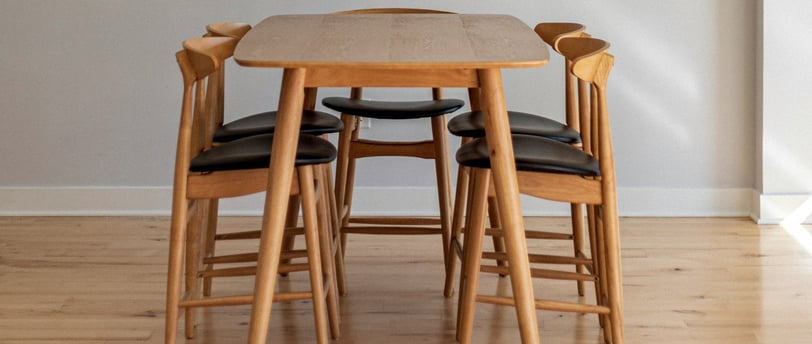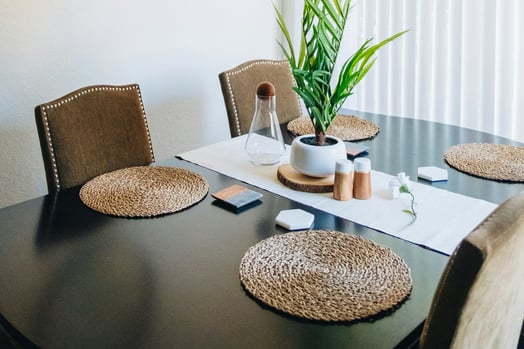8 Tricks to Select the Right Dining Table Size for Your Space
Learn how to select the right dining table size for your space with expert tips on measurements, seating capacity, and room layout. Find the perfect fit for comfort and style in your dining area.
FURNITUREORGANISING
1/30/20253 min read


Choosing the right dining table size is crucial for creating a functional and aesthetically pleasing dining area. A table that is too large can make the room feel cramped, while one that is too small may not provide enough seating for family and guests. To help you make the best choice, this guide will walk you through essential considerations, including room dimensions, table shapes, and seating capacity.
1. Measure Your Dining Space
Before selecting a dining table, it’s essential to measure the area where you plan to place it. Ensure that you leave enough space for movement and comfortable seating.
Room dimensions: Use a tape measure to determine the length and width of your dining area.
Clearance space: Allow at least 36 inches (3 feet) between the table and walls or other furniture for easy movement.
Pathways: If your dining area connects to other rooms, ensure sufficient space for walkways.
2.Consider_Seating Capacity
The number of people you plan to seat regularly and on special occasions will influence the size of your dining table. Here are some general guidelines:
4-seater table: Ideal for small spaces, requires a diameter of 36-48 inches (round) or a length of 48 inches (rectangular).
6-seater table: A medium-sized option, needing a diameter of 48-60 inches (round) or 60-72 inches (rectangular).
8-seater table: Suitable for larger families, requiring at least 72 inches (rectangular) or 60 inches (round).
10+ seater table: Best for spacious dining areas, needing a rectangular table of 96+ inches in length.
3. Choose the Right Table Shape
The shape of your dining table affects both aesthetics and functionality. Different table shapes work better for specific room layouts and seating arrangements.
Rectangular: The most common shape, ideal for long dining areas and seating more people.
Round: Great for smaller spaces, promotes conversation, and fits well in square rooms.
Oval: A softer alternative to rectangular tables, providing a spacious yet elegant look.
Square: Best suited for compact dining areas and small gatherings.
4. Account for Table Extensions
If you occasionally need extra seating, consider an extendable dining table. These tables feature foldable or removable leaves, allowing flexibility for different occasions.
Drop-leaf tables: Compact when not in use but can expand when needed.
Butterfly-leaf tables: Feature built-in extensions that easily slide into place.
Expandable tables: Can increase seating capacity without taking up too much space permanently.
5. Evaluate the Table Height and Leg Style
Standard dining tables are around 28-30 inches high, providing comfortable seating with standard dining chairs. However, different leg styles impact the usability of the space.
Pedestal base: Offers more legroom and flexibility in seating arrangements.
Trestle base: Provides a sturdy foundation and suits rustic or farmhouse-style decor.
Four-legged tables: The traditional design but can limit chair placement.
6. Match the Table to Your Decor Style
Your dining table should complement your interior design. Consider materials and finishes that blend seamlessly with your space.
Wood: Timeless and durable, works well in traditional and rustic interiors.
Glass: Creates an airy and modern aesthetic, making small spaces feel larger.
Metal: Ideal for industrial or contemporary styles, offering durability and sleekness.
Marble: Luxurious and elegant, adding sophistication to any dining room.
7. Factor in Maintenance and Durability
Choosing a dining table involves considering maintenance and longevity. Some materials require more care than others.
Solid wood: Sturdy but requires occasional polishing and care against scratches.
Glass: Easy to clean but prone to fingerprints and smudges.
Laminate: Low maintenance and budget-friendly, resistant to scratches and stains.
Marble: Stunning but requires sealing and regular upkeep to prevent staining.
8. Test Before You Buy
Before making a purchase, it’s helpful to test the table’s size and comfort level.
Visit showrooms to visualize the table in real-life settings.
Use masking tape to outline dimensions on your floor to check fit.
Sit around a similar table to ensure enough elbow room and leg space.
Conclusion
Selecting the right dining table size involves balancing aesthetics, functionality, and comfort. By considering room dimensions, seating needs, table shape, and materials, you can find the perfect dining table that enhances your space. Whether you prefer a cozy, intimate setup or a large table for entertaining guests, these tips will help you make an informed choice for a stylish and comfortable dining area.


Follow Us
Explore smart furniture ideas for modern living.
For Enquiry
contact: info@urbanspacee.com,
+91 91886 37751
© 2025. All rights reserved./Terms and Conditions/Privacy policy
Newsletters
This blog contains affiliate links.For promoting there products ,we may earn a commission if you purchase through these links, at no extra cost to you.
